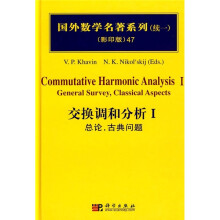Introduction
Chapter 1.A Short Course of Fourier Analysis of Periodic Functions
§1.Translation-Invariant Operators
1.1.The Set up
1.2.Object ofInvestigation
1.3.Convolution
1.4.General Form oft.i.Operators
§2.Harmonics.Basic Principles of Harmonic Analysis on the Circle
2.1.Eigenvectors and Eigenfunctions of t-i.Operators
2.2.Basic Principles of Harmonic Analysis on the Circle T
2.3.Smoothing ofDistributions
2.4.WeierstrassTheorem
2.5.Fourier Coefficients.The Main Theorem of Harmonic Analysis on the Circle
2.6.Spectral Characteristics of the Classes * and *
2.7.L2-Theory of Fourier Series
2.8.WirtingerS Inequality
2.9.The lsoperimetric Inequality.(HurwitzProof)
2.10.Harmonic Analysis on the Torus
Chapter 2.Harmonic Analysis in Rd
§1.Preliminaries on Distributions in Rd
1.1.Distributions in Rd
§2.From the Circle to the Line.Fourier Transform in Rd(Definition)
2.1.Inversion Formula(An Euristic Derivation)
2.2.A Proofofthe Inversion Formula
2.3.Another Proof
2.4.Fourier Transform in Rd(Definition)
§3.Convolution(Definition).
3.1.Difficulties of Harmonic Analysis in Rd
3.2.Convolution of Distributions(Construction)
3.3.Examples
3.4.Convolution Operators
§4.Convolution Operators as Object of Study(Examples)
4.1.Linear Ditierential and Difference Operators.
4.2.Integral Operators with a Kernel Depending on Difference of Arguments.
4.3.Integration and Differentiation of a Fractional Order.
4.4.Hilbert Transform
4.5.CauchyS Problem and Convolution Operators
4.6.Fundamental Solutions.The Newtonian Potential
4.7 Distribution of the Sum of Independent Random Variables
4.8 Convolution Operators in Approximation Theory
4.9.The Impulse Response Function ofa System.
§5.Means of InVestigation-Fourier Transform(S′-Theory and L2-Theory
5.1.Spaces S and S′
5.2.S′-Theory of Fourier Transform.Preliminary Discussion
5.3.S′-Theory of Fourier Transform(Basic Facts)
5.4.L2 Theory.
5.5.“x-Representation”and“”
§6.Fourier Transform in Examples
6.1.Some Formulae
6.2.Fourier Transform and a Linear Change of Variable
6.3 Digression:Heisenberg Uncertainty Principle
6.4.Radially-Symmetric Distributions
6.5 Harmonic Analysis of Periodic Functions
6.6.The Poisson Summation Formula
6.7.MinkowskiS Theorem on Integral Solutions of Systems of Linear Inequalities.
6.8.Jacobis Identity for the
6.9.Evaluation ofthe Gaussian Sum.
§7.Fourier Transform in Action.Spectral Analysis of Convolution Operators
7.1.Symbol
7.2.Construction of Fundamental Solutions
7.3.Hypoellipticity
7.4 Singular Integral Operators and PDO
7.5 The Law of Large Numbers and Central Limit Theorem
7.6.
7.7.Tauberian Theorems
7.8.Spectral Characteristic of a System.
7.9. More on Summation Methods
8. Additional Remarks
8.1. Fourier Transform in. Ultra-Distributions
8.2. Certain Generalizations of the L2-Theory
8.3. Radon Transform
Chapter 3. Harmonic Analysis on Groups
1. An Outline of Harmonic Analysis on a Compact Group
1.1. A New Set Up
1.2. Harmonics
1.3. Representations
1.4. The Peter-H. Weyl Theorem
2. Commutative Harmonic Analysis
2.1. Simplifications Implied by Commutativity
2.2. Fourier Transform of Measures and Summable Functions
2.3. Convolution
2.4. Uniqueness Theorem. The Inversion Formula
2.5. Classical Harmonic Analysis from a General Point of View
2.6. Fast Multiplication of Large Numbers
2.7. Plancherels Theorem
2.8. The Theorem of Bochner and A. Weil
3. Examples
3.1. Pontryagins Duality Theorem
3.2. Almost Periodic Functions
3.3. Quadratic Reciprocity Law
4. Unitary Representations of the Group R
4.1. Stones Theorem
4.2. Infinitesimal Generator
4.3. Examples
Chapter 4. A Historical Survey
Chapter 5. Spectral Analysis and Spectral Synthesis. Intrinsic Problems of Harmonic Analysis
1. Harmonic Analysis "For Itself"
2. Spectral Analysis
2.1. Linear Combination of Exponentials
2.2. Generalizations
2.3. Spectrum
3. Spectral Synthesis
3.1. Methods of Synthesis
3.2. Spectral Analysis-Synthesis of t.i. Operators According to L. Schwartz
3.3. Continuation, Periodicity in the Mean and Stability
3.4. Problems of Translation
3.5. Exceptional Sets
4. Translation-Invariant Operators. Singular Integrals, Multipliers
5. Complex-Analytic Methods
Epilogue
Bibliographical Notes
References

 缺书网
缺书网 扫码进群
扫码进群






